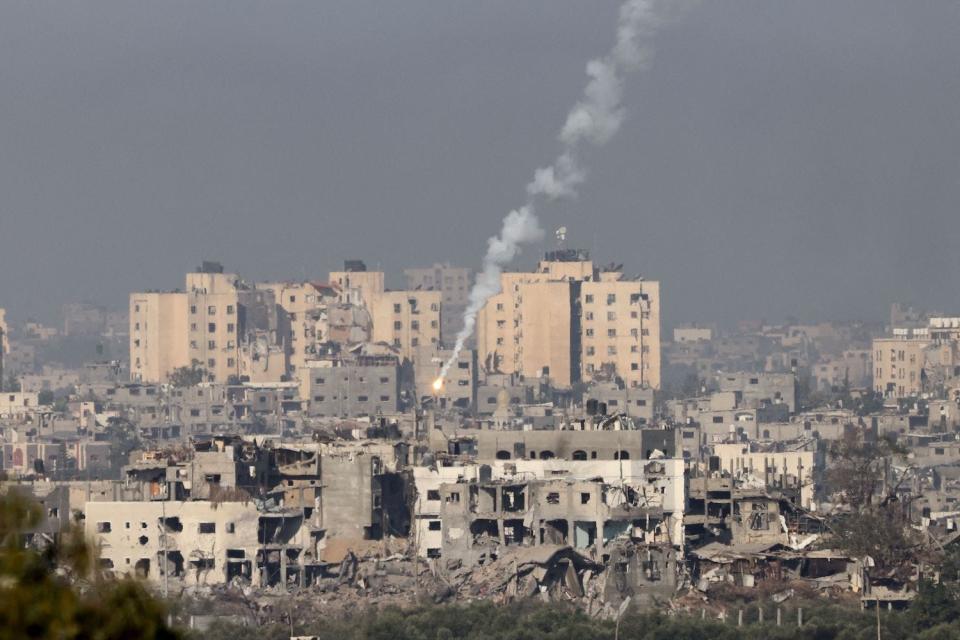It took a bloody fight against traps, hidden enemies, and more for Israel to surround Gaza City, and it could get even worse as its forces move in
Israeli forces appear to have encircled Gaza City, a week after expanding ground operations.
In that time, the IDF has been met by anti-tank fire, surprise attacks, and more assaults by Hamas.
A major urban fight inside Gaza City, which appears imminent, could be a lot more costly.
After a week of expanded ground operations inside the Gaza Strip, Israeli forces appear to have encircled the coastal enclave's main city. It's the result of a bloody advance that may soon become even more costly as the urban fight intensifies.
The Israel Defense Forces (IDF) "are encircling Gaza City from the air, the land, and the sea," Rear Adm. Daniel Hagari said at a press briefing on Friday. He said Israeli troops are "advancing in battles," destroying Hamas infrastructure, and killing militants, as well as eliminating tunnels belonging to the group.
According to open-source intelligence accounts and positional mapping from the Institute for the Study of War, a Washington-based think tank monitoring the conflict, the IDF has approached the city along multiple axes. Israeli forces are operating in the northeast and northwest corners of Gaza, and to the south, the IDF has effectively severed the strip into two halves by driving a wedge that runs from the border to the Mediterranean Sea.
Israel has repeatedly urged the population of northern Gaza — some 1 million people, and where Gaza City is located — to evacuate to the south both before and after the expanded ground offensive began in late October.
Over the past several days, as Israeli forces closed in on Gaza City, they have faced an array of different threats from Hamas while engaging in combat inside the enclave. Among them, the IDF has said, are anti-tank missiles, improvised explosive devices (IEDs), grenades thrown at troops, and ambushes conducted by way of the militant group's notorious underground tunnel network. The military has released photographs and videos showing infantry and armor operating in unspecified locations throughout the strip.

Hamas, meanwhile, has published a handful videos to social media that show intense gun battles, rocket fire, and drone attacks on Israeli troops and heavy armor. Insider has been unable to immediately verify all of the footage. So far, around two dozen Israeli soldiers — and an unclear number of Hamas militants — have reportedly been killed since the beginning of the ground invasion. With Gaza City now effectively encircled and a deeper assault on it appearing imminent, the casualty figures could continue to rise.
Lt. Gen. Herzi Halevi, the IDF chief of staff, said on Thursday that his forces had already been operating inside Gaza City for several days and have engaged in "close combat" with Hamas militants.
"The soldiers are fighting in an urban, crowded and complex area that necessitates fighting in a very professional and courageous way," he said in a statement. "The ground forces are supported by precise intelligence, with supporting fire from the air and the sea."
War experts say the urban fight as Israeli troops move into the city is likely be extremely difficult for the IDF, which will be forced to contend with more booby traps, guerilla-style surprise assaults, and the complicated — and massive — labyrinth of subterranean tunnels. Current and former US military leaders have warned that ground operations could be more difficult than even the toughest battle against the Islamic State.
Further complicating IDF advances are the more than 200 hostages who were captured by Hamas during its October 7 terror attacks in southern Israel, which killed over 1,400 people, and the Palestinian civilians who still remain in the area, which has been subject to intense bombardment for weeks.

As the death toll among Palestinians continues to rise — an estimated 9,000 people according to the Hamas-run health ministry — there has been a sharp increase in calls for a ceasefire from the international community and some American lawmakers. But top US and Israeli officials, including Prime Minister Benjamin Netanyahu, have consistently dismissed the growing pressure to halt fighting.
"We aren't advocating for a general ceasefire at this point," White House National Security Council Spokesperson John Kirby said at a briefing on Thursday. "We believe that a general ceasefire would benefit Hamas in providing them breathing space and time to continue to plot and execute attacks on the Israeli people."
Also speaking to reporters on Thursday, Pentagon Press Secretary Air Force Brig. Gen. Pat Ryder said Washington does, however, "support humanitarian pauses" to facilitate the movement of aid into Gaza and get hostages and other civilians out of the besieged enclave.
Beyond Gaza, the Israeli military continues to face attacks from Iran-backed groups in other directions. Along Israel's northern border, Lebanon's Hezbollah continues to exchange sporadic fire with the IDF on a routine basis, as the two sides have done for nearly a month. To the south, Houthi militants in Yemen have launched several drones and missiles, including a suspected ballistic missile attack that forced Israel to deploy its Arrow air-defense system for the first time since the conflict began and move ships into the Red Sea to provide further protection.
Iran-backed aggression has also been seen elsewhere in the Middle East. The Pentagon said on Thursday that there have been 28 attacks on US forces in Iraq and Syria since October 17, including eight in the last week alone.
Read the original article on Business Insider

